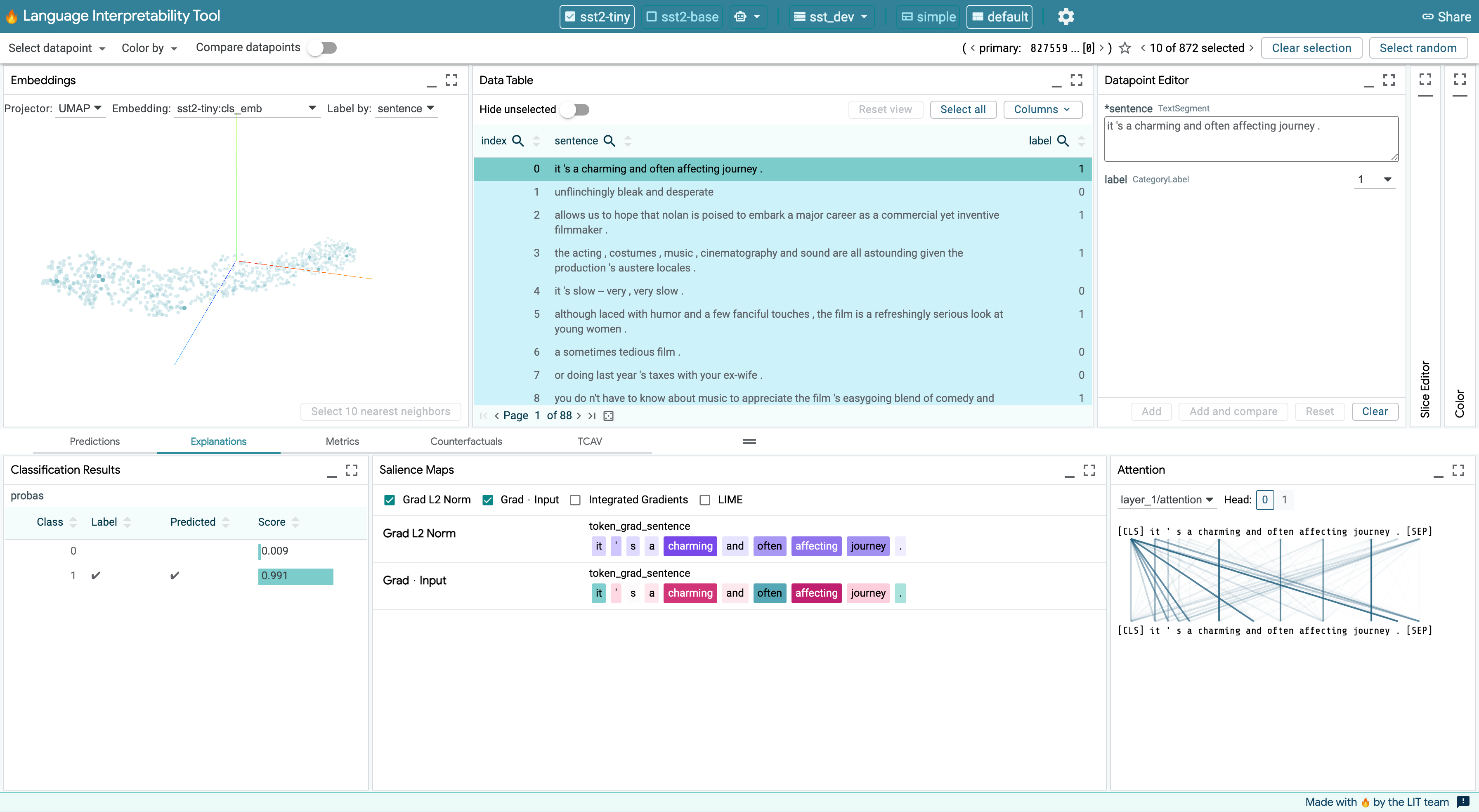The Language Interpretability Tool (LIT) is a visual, interactive ML model-understanding tool that supports text, image, and tabular data. It can be run as a standalone server, or inside of notebook environments such as Colab, Jupyter, and Google Cloud Vertex AI notebooks.
LIT is built to answer questions such as:
- What kind of examples does my model perform poorly on?
- Why did my model make this prediction? Can this prediction be attributed to adversarial behavior, or to undesirable priors in the training set?
- Does my model behave consistently if I change things like textual style, verb tense, or pronoun gender?
LIT supports a variety of debugging workflows through a browser-based UI. Features include:
- Local explanations via salience maps, attention, and rich visualization of model predictions.
- Aggregate analysis including custom metrics, slicing and binning, and visualization of embedding spaces.
- Counterfactual generation via manual edits or generator plug-ins to dynamically create and evaluate new examples.
- Side-by-side mode to compare two or more models, or one model on a pair of examples.
- Highly extensible to new model types, including classification, regression, span labeling, seq2seq, and language modeling. Supports multi-head models and multiple input features out of the box.
- Framework-agnostic and compatible with TensorFlow, PyTorch, and more.
LIT has a website with live demos, tutorials, a setup guide and more.
Stay up to date on LIT by joining the lit-announcements mailing list.
For a broader overview, check out our paper and the user guide.
LIT can be installed via pip or built from source. Building from source is
necessary if you update any of the front-end or core back-end code.
Clone the repo and set up a Python environment:
git clone https://github.com/PAIR-code/lit.git ~/lit
# Set up Python environment
cd ~/lit
conda env create -f environment.yml
conda activate lit-nlp
conda install cudnn cupti # optional, for GPU support
conda install -c pytorch pytorch # optional, for PyTorch
# Build the frontend
pushd lit_nlp; yarn && yarn build; popdNote: if you see an error
running yarn on Ubuntu/Debian, be sure you have the
correct version installed.
pip install lit-nlpThe pip installation will install all necessary prerequisite packages for use
of the core LIT package.
It does not install the prerequisites for the provided demos, so you need to install those yourself. See environment.yml for the list of packages required to run the demos.
Explore a collection of hosted demos on the LIT website demos page.
To explore classification and regression models tasks from the popular GLUE benchmark:
python -m lit_nlp.examples.glue_demo --port=5432 --quickstartNavigate to http://localhost:5432 to access the LIT UI.
Your default view will be a small BERT-based model fine-tuned on the Stanford Sentiment Treebank, but you can switch to STS-B or MultiNLI using the toolbar or the gear icon in the upper right.
To explore predictions from a pre-trained language model (BERT or GPT-2), run:
python -m lit_nlp.examples.lm_demo --models=bert-base-uncased --port=5432And navigate to http://localhost:5432 for the UI.
Colab notebooks showing the use of LIT inside of notebooks can be found at google3/third_party/py/lit_nlp/examples/notebooks.
We provide a simple Colab demo. Run all the cells to see LIT on an example classification model in the notebook.
See docker.md for instructions on running LIT as a containerized web app. This is how we run our hosted demos.
See lit_nlp/examples. Run similarly to the above:
python -m lit_nlp.examples.<example_name> --port=5432 [optional --args]To learn about LIT's features, check out the user guide, or watch this video.
You can easily run LIT with your own model by creating a custom demo.py
launcher, similar to those in lit_nlp/examples. The
basic steps are:
- Write a data loader which follows the
DatasetAPI - Write a model wrapper which follows the
ModelAPI - Pass models, datasets, and any additional components to the LIT server class
For a full walkthrough, see adding models and data.
LIT is easy to extend with new interpretability components, generators, and more, both on the frontend or the backend. See our documentation to get started.
To make code changes to LIT, please work off of the dev branch and
create pull requests
(PRs) against that branch. The main branch is for stable releases, and it is
expected that the dev branch will always be ahead of main.
Draft PRs are encouraged, especially for first-time contributors or contributors working on complex tasks (e.g., Google Summer of Code contributors). Please use these to communicate ideas and implementations with the LIT team, in addition to issues.
Prior to sending your PR or marking a Draft PR as "Ready for Review", please run the Python and TypeScript linters on your code to ensure compliance with Google's Python and TypeScript Style Guides.
# Run Pylint on your code using the following command from the root of this repo
pushd lit_nlp & pylint & popd
# Run ESLint on your code using the following command from the root of this repo
pushd lit_nlp & yarn lint & popdIf you use LIT as part of your work, please cite our EMNLP paper:
@misc{tenney2020language,
title={The Language Interpretability Tool: Extensible, Interactive Visualizations and Analysis for {NLP} Models},
author={Ian Tenney and James Wexler and Jasmijn Bastings and Tolga Bolukbasi and Andy Coenen and Sebastian Gehrmann and Ellen Jiang and Mahima Pushkarna and Carey Radebaugh and Emily Reif and Ann Yuan},
booktitle = "Proceedings of the 2020 Conference on Empirical Methods in Natural Language Processing: System Demonstrations",
year = "2020",
publisher = "Association for Computational Linguistics",
pages = "107--118",
url = "https://www.aclweb.org/anthology/2020.emnlp-demos.15",
}
This is not an official Google product.
LIT is a research project and under active development by a small team. There will be some bugs and rough edges, but we're releasing at an early stage because we think it's pretty useful already. We want LIT to be an open platform, not a walled garden, and we would love your suggestions and feedback - drop us a line in the issues.
